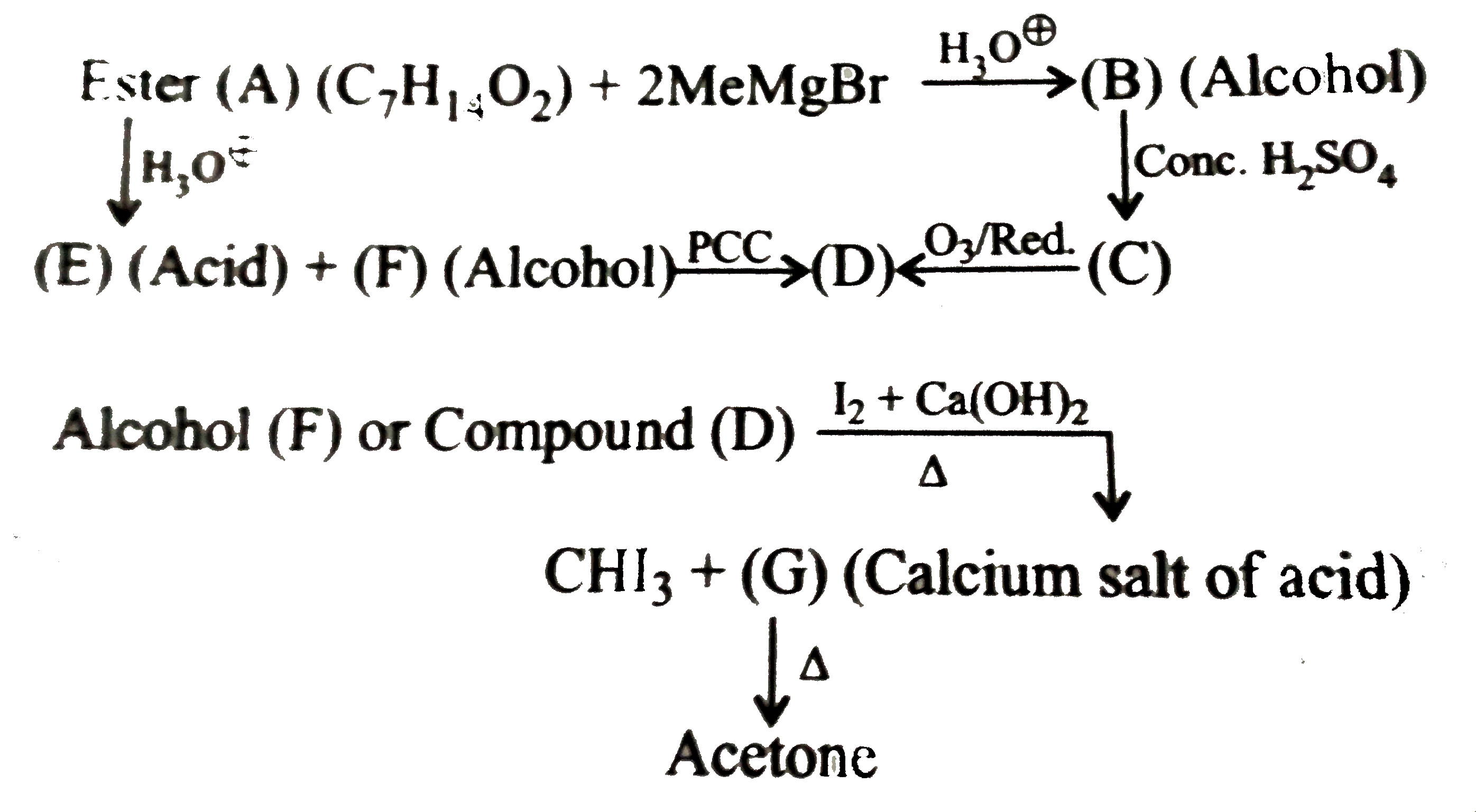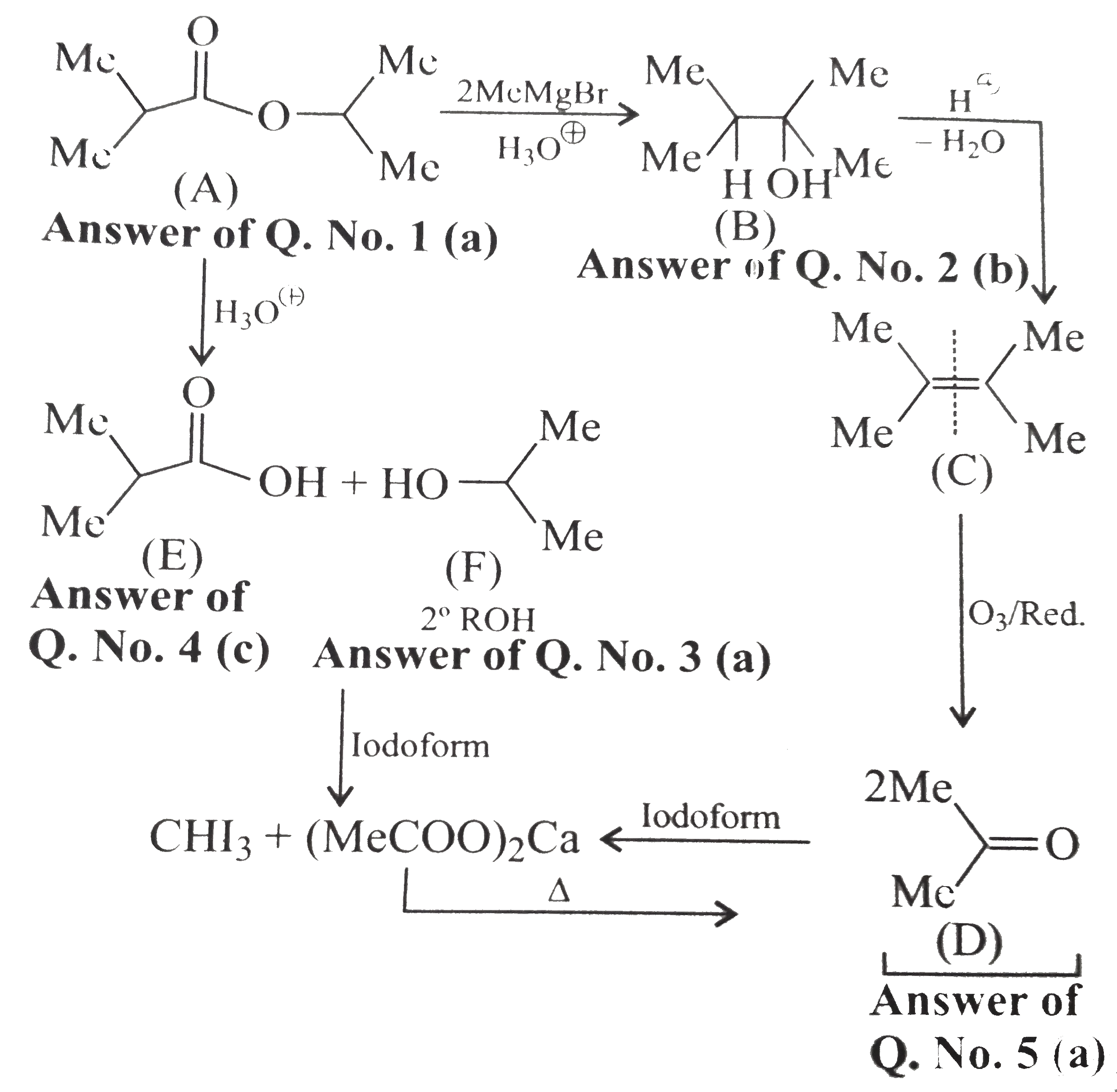
Acid (E) is :



MeCOOH
The correct Answer is:C
(c) (i) Acetone obtained from (G) suggests that (G) is calcium acetate, (CH3COO)2Ca.
(ii) Therefore, compound (D) is acetone (Me2C=O)
(iii) Thus, compound (F) would be isopropyl alcohol (Me2CHOH).
(iv) Since (D) is obtained from (C),(C) would be 
(v) (B) would be 
(vi) Structure of (D) and (F) suggest that ester (A) should be  .
.
Reactions :
 .
.
Topper's Solved these Questions
- CARBOXYLIC ACIDS AND THEIR DERIVATIVESBOOK - CENGAGE CHEMISTRYCHAPTER - CARBOXYLIC ACIDS AND THEIR DERIVATIVESEXERCISE - Exercises (Multiple Correct)
35 Videos
- CARBOXYLIC ACIDS AND THEIR DERIVATIVESBOOK - CENGAGE CHEMISTRYCHAPTER - CARBOXYLIC ACIDS AND THEIR DERIVATIVESEXERCISE - Exercises (Singlecorrect)
64 Videos
- CARBOXYLIC ACIDS AND THEIR DERIVATIVESBOOK - CENGAGE CHEMISTRYCHAPTER - CARBOXYLIC ACIDS AND THEIR DERIVATIVESEXERCISE - Exercises (Subjective)
19 Videos
- BIOMOLECULES, POLYMERS AND CHEMISTRY IN EVERYDAY LIFEBOOK - CENGAGE CHEMISTRYCHAPTER - BIOMOLECULES, POLYMERS AND CHEMISTRY IN EVERYDAY LIFEEXERCISE - QUESTION BANK
8 Videos
- CHEMICAL KINETICSBOOK - CENGAGE CHEMISTRYCHAPTER - CHEMICAL KINETICSEXERCISE - Archives Subjective
23 Videos
Similar Questions
Alkenes (A) and (B) yield the same alcohol (C) on hydration. On vigorous oxidation with KMnO4, (A) gives a carbonyl compound (D) and an acid (E) each containing four carbon atoms. On the other hand, (B) gives an acid (E) and a carbonyl compound (G). In (G) no two identical groups are attached to the same carbon atom. Give the structures of (A) to (G).
View SolutionWhich carboxylic acid (B)(N.E=52gmeq−1) loses CO2 when heated to give an acid (C)N.E=60gmeq−1 ?
View Solution
Knowledge Check
A weak acid (or base) is titrated against a strong base (or acid), volume V of strong base (or acid) is plotted against pH of the solution (as shown in fig).The weak electrolyte (i.e., acid or base) could be:
 ANa2CO3BNa2C2O4CH2C2O4DCH4(COOH)2
ANa2CO3BNa2C2O4CH2C2O4DCH4(COOH)22E+N2→2EN (very hard substance)
EN+H2O→ Acid + pungent smelling gas Acid is:AHNO3BH3BO3CHNO2Dcan be A & B
Give the IUPAC names of the following compounds:
(a) Glycerol (b)Acetone
(c) Formic acid (d) Oxalic acid
(e) Isopropyl alcohol (f) Acetaldehyde
(g) Acetylene (h) Ethy l alcohol
(i) Acetic acid (j) Ethylene
(k) Vinyl cyanide
View SolutionWhich of the following materials fall in the category of a pure substance ?
(a) Ice
(b) Milk
(c ) Iron
(d) Hydrochloric acid
(e ) Calcium oxide
(f) Mercury
(g) Brick
(h) Wood
(i) Air.
View SolutionConvert the following :
(a)
(b)PhH(Benzene)(I)PhCOOH(II)(Benzoic acid)
( c)
(d)
( e)
(f)
(g)
(h)
(i) MeCOOH(I)(Acetic acid)→(CH2(COOH)2)(Malonic acid)(II)
View SolutionAn organic compound (A) (C5H7OCl) reacts rapidly with ethanol to give (B) (C7H12O2). (A) also reacts with water to produce an acid which reacts with bromine to give (C ) (C5H8Br2O2). (B) on boiling with H2SO4 forms an acid (D). When (D) is oxidised with KMnO4 an acid (E ) (C4H6O3) is produced. On mild heating, (E ) gives (F) (C3H6O) which cannot be oxidised by ammoniacal AgNO3. Identify the compounds (A) to (F).
View Solution(a) Why is boric acid considered as a weak acid.
(b) Discuss the structure of disborane?
(c) What is borazin e?
(d) what are silicones?
View SolutionWhat is the oxidation number of nitrogen in (a) nitric acid (b) nitrous acid (c) nitric oxide (d) nitrous oxide (e) ammonia (f) N2 ?
View Solution
